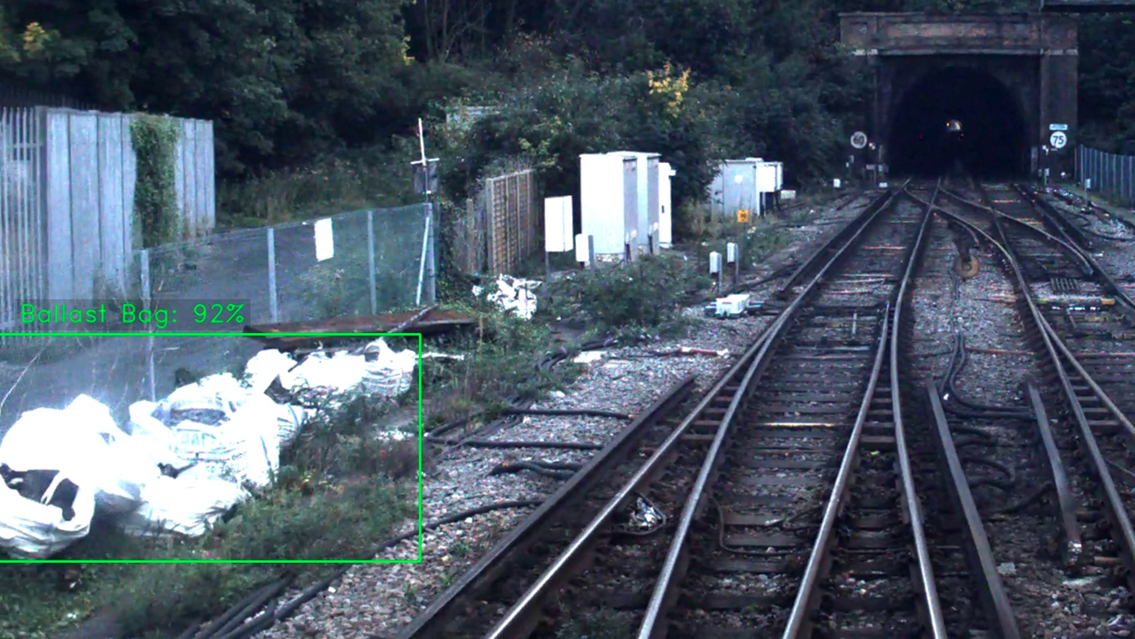Thursday 22 Jun 2023
Scrap that: Video and AI technology helping keep the railway tidy and railway workers safe
- Region & Route:
- Southern
- | Southern: Wessex
Artificial intelligence software is helping Network Rail find and remove forgotten scrap materials from the side of the railway more quickly and safely than ever before.
Network Rail Southern region is spearheading a trial of One Big Circle’s video and AI technology to locate old railway kit that can either be re-used or recycled, reduce the risk of injury to colleagues from slips, trips and falls, and tidy up the railway at the same time.
The technology captures high-definition train’s-eye-view video – known as Automated Intelligent Video Review (AIVR) – from across the rail network, with the footage instantly accessible in the cloud.
The footage is then analysed by AI to find scrap rail, sleepers and bags of ballast and map their locations using GPS, enabling maintenance teams to plan how and when to safely remove the items.
Wayne Cherry, Network Rail senior innovations engineer, said: “Technology such as AIVR provides Network Rail with a brilliant opportunity to improve how efficient we are as a business.
“While AIVR is already in use across other parts of Network Rail, this will be the first time this technology has been used in this way with AI and could be a real game-changer.
“Not only is scrap on the side of the railway unsightly, but it can also become an obstacle during planned engineering work, block safe walkways or delay our teams accessing part of the railway infrastructure to make repairs during disruption.
“If we can become safer and more efficient with identifying and removing scrap material, it will not only help our colleagues stay safe, but benefit the wider rail industry, passengers and the taxpayer.”
The project is currently being trialled on the Wessex route – which is one of the busiest on the rail network, taking in all or part of the counties of Surrey, Berkshire, Hampshire, Dorset, Devon, Somerset and Wiltshire – before looking to roll it out more widely.
In addition to helping improve efficiency, the new technology also has safety and financial advantages.
On Network Rail’s Wessex route, ‘slips, trips and falls’ are the largest causes of injury and scrap on the side of the track is a significant hazard, particularly as most work happens during darkness.
Martyn Shaftoe, Network Rail’s Wessex route health and safety advisor, who is leading this project, said: “We are delighted to be working in partnership with One Big Circle on this exciting project. I believe this technology will play an important role in helping keep our front-line colleagues safe, help us become more efficient in locating and removing scrap, as well as improving the overall condition of the railway for the benefit of our passengers and local residents.
“Unfortunately, over recent years, the railway has become somewhat of a dumping ground for discarded railway sleepers, scrap rail, redundant ballast bags and many other assets. The challenge we face is there is no definitive list of where these materials or assets are.
“The prospect of accurately locating scrap material using high-definition video footage and AI without the need for colleagues to walk along the railway is a huge safety improvement opportunity.”
Financially, not only can some of the scrap material be recycled and any money accrued used to support running of the railway, but some of the leftover materials are also reusable. For example, Bomac concrete sleepers are no longer manufactured, but there is still a demand for them as replacements on sidings and on some stretches of track. Thanks to this technology, 40 of these sleepers have been identified on a site between Yeovil and Weymouth where they can be recovered and stored for future use across the business, preventing the need to buy costly new equivalents.
Martyn added: “To be able to help the industry potentially save money by reusing or recycling this treasure-trove of scrap materials is a brilliant prospect and we look forward to hopefully rolling it out more widely across the business later in the year.”
Emily Kent, One Big Circle co-founder and director, said: “This is a really exciting application of AI developed in collaboration with Network Rail experts.
“The AIVR system collects high quality lineside imagery from across the whole of the UK to help many different engineers and disciplines see what they need to see without attending site.
“Adding further intelligence to that data - as with this automatic detection and location of scrap rail and other lineside hazards - really enables you to hone in on specific issues and respond to them quickly and safely.”
Contact information
Passengers / community members
Network Rail national helpline
03457 11 41 41
Latest travel advice
Please visit National Rail Enquiries
Journalists
Rob Breckon
Head of Communications - Eastern
Network Rail
07395 390759
rob.breckon@networkrail.co.uk
About Network Rail
We own, operate and develop Britain's railway infrastructure; that's 20,000 miles of track, 30,000 bridges, tunnels and viaducts and the thousands of signals, level crossings and stations. We run 20 of the UK's largest stations while all the others, over 2,500, are run by the country's train operating companies.
Usually, there are almost five million journeys made in the UK and over 600 freight trains run on the network. People depend on Britain's railway for their daily commute, to visit friends and loved ones and to get them home safe every day. Our role is to deliver a safe and reliable railway, so we carefully manage and deliver thousands of projects every year that form part of the multi-billion pound Railway Upgrade Plan, to grow and expand the nation's railway network to respond to the tremendous growth and demand the railway has experienced - a doubling of passenger journeys over the past 20 years.
Follow us on Twitter: @networkrail
Visit our online newsroom: www.networkrailmediacentre.co.uk

